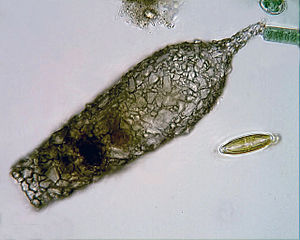Testate amoebae: Difference between revisions
No edit summary |
|||
| Line 2: | Line 2: | ||
= Overview = | = Overview = | ||
'''Testate amoeba''' (Testacea, or Hyalosphenia) are amoeboid protists, differing from [[naked amoebae|naked amoeba]] in that they inhabit a test, or shell. The '''test''' of the testate can be created entirely by the [[amoeba]], in which it would create an organic, siliceous, or calcareous shell depending on the species of testate amoeba. These tests created entirely by the amoeba are known as '''autogenic tests''', as seen in Figure 2. An '''xenogenic test''' is made up of particles of sediment collected by the amoeba which are then agglutinated together by secretions within the cell, as seen in Figure 3. | '''Testate amoeba''' (Testacea, or Hyalosphenia) are amoeboid protists, differing from [[naked amoebae|naked amoeba]] in that they inhabit a test, or shell. The '''test''' of the testate can be created entirely by the [[amoeba]], in which it would create an organic, siliceous, or calcareous shell depending on the species of testate amoeba. These tests created entirely by the amoeba are known as '''autogenic tests''', as seen in Figure 2. An '''xenogenic test''' is made up of particles of sediment collected by the amoeba which are then agglutinated together by secretions within the cell, as seen in Figure 3. | ||
[[File: Arcella_discoides.jpg|thumb|300x300px|Figure 2: The ''autogenic'' test of Arcella discoides, made up of organic plates..]] | [[File: Arcella_discoides.jpg|thumb|300x300px|left|Figure 2: The ''autogenic'' test of Arcella discoides, made up of organic plates..]] | ||
[[File:Difflugia_acuminata.jpg|thumb|300x360px|Figure 3: An ''xenogenic test'' of a Difflugia acuminata. Depicts an agglutinated test made up of mineral particles glued together with secretions from within the cell.]] | [[File:Difflugia_acuminata.jpg|thumb|300x360px|Figure 3: An ''xenogenic test'' of a Difflugia acuminata. Depicts an agglutinated test made up of mineral particles glued together with secretions from within the cell.]] | ||
Revision as of 17:48, 6 May 2021

Overview
Testate amoeba (Testacea, or Hyalosphenia) are amoeboid protists, differing from naked amoeba in that they inhabit a test, or shell. The test of the testate can be created entirely by the amoeba, in which it would create an organic, siliceous, or calcareous shell depending on the species of testate amoeba. These tests created entirely by the amoeba are known as autogenic tests, as seen in Figure 2. An xenogenic test is made up of particles of sediment collected by the amoeba which are then agglutinated together by secretions within the cell, as seen in Figure 3.


Significance
The shells which these protozoa develop are able to be preserved long after the amoeba has died. This characteristic combined with Testacea sensitivity to environmental factors, such as pH, temperature, etc., has shown their usefulness as bioindicators and paleoclimate proxies.
Their use as bioindicators have been researched and discussed in a variety of scientific papers. One in particular looked at the testate amoeba as indicators for the transition between bog and forested environments [2]. Differences could be seen when looking at forested areas, where there would only be smaller and bacterivorous testate amoeba with smaller aperture sizes. Whereas in bog environments, there were large numbers of bigger, mixotrophic testate amoeba, which were absent in the forested environment. This change in environment leads to a decrease in mixotrophic productivity and shows testacea as useful bioindicators [2].
Due to their variability from small changes in pH, water table depth, and other environmental gradients, testate amoeba have become a valuable bioindicator. They are particularly useful as bioindicators for the evaluation of peatlands, lake trophic status, and water quality as a whole [5][6].
Habitat & Dietary Processes
This group of free-living microorganisms inhabit aquatic to moist habitats including: estuaries, lakes, rivers, wetlands, soils, litter, and moss habitats. They are able to live in both fresh and marine water, however, compared to naked amoeba, testate amoebae are less abundant in most soils. They thrive in soil environments that are moist and within forested systems.
When in soils, these protist consume a variety of other microbial organisms including: bacteria, fungi, microalgae, ciliates, rotifers and nematodes. This allows them to play a key role in carbon and nutrient cycling.
Similar to naked amoeba, testate amoeba also have pseudopodia which they use to consume other organisms and manipulate their environment. However, differing from naked amoeba, testacea have a aperture from which the pseudopodia emerge. This allows for greater protection of the protist from predators and harmful environmental conditions.
References
[1] Coleman, D.J., Callaham, M. A., Jr., Crossley, D.A.. November 2017. 'The Fundamentals of Soil Ecology'. Third Edition. Elsevier Academic Press.
[2] Creevy, Angela L., Anderson, Roxane, Rowsen, James G., Payne, Richard J. January 2018. 'Testate amoebae as functionally significant bioindicators in forest-to-bog restoration'. Ecological Indicators. Elsevier. 84. 274-282.
[3] Louiser, J.D., Parkinson, S.S.. 1981. 'Evaluation of a membrane filter technique to count soil and litter Testacea'. Soil Biol. Biochem. 13. 209-2013
[4] Mitchell, Edward A. D.; Charman, Daniel J.; Warner, Barry G. 2008. "Testate amoebae analysis in ecological and paleoecological studies of wetlands: past, present and future" (PDF). Biodiversity and Conservation. 17 (9): 2115–2137. doi:10.1007/s10531-007-9221-3. ISSN 0960-3115.